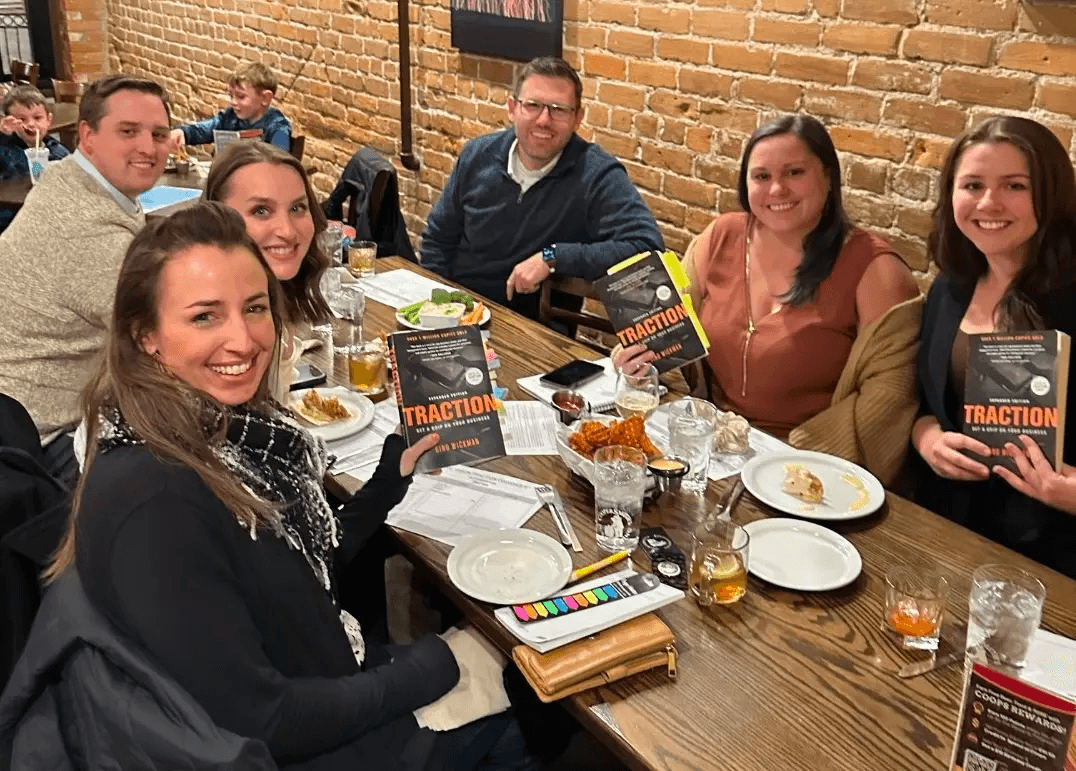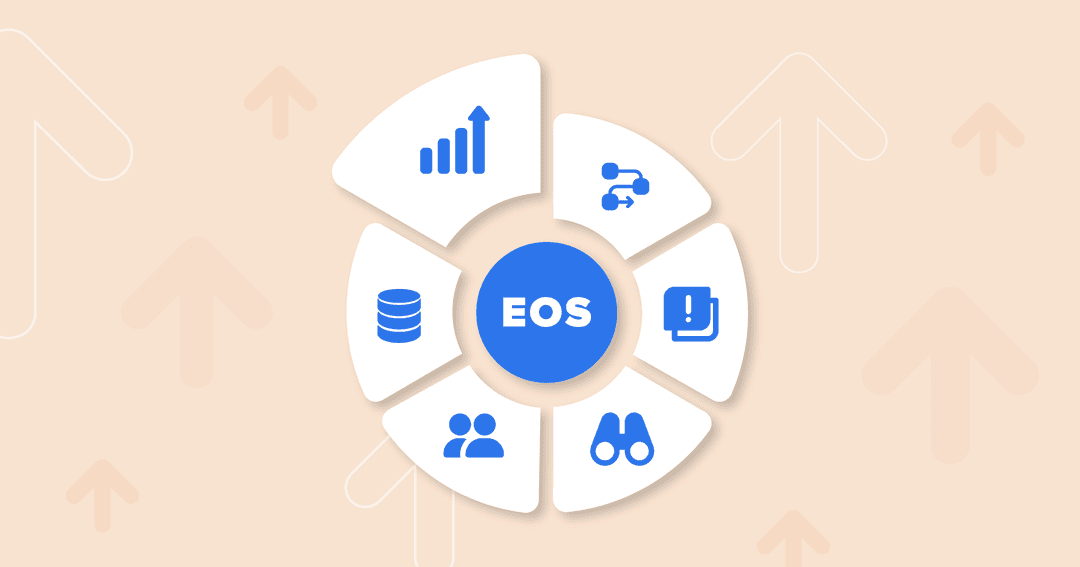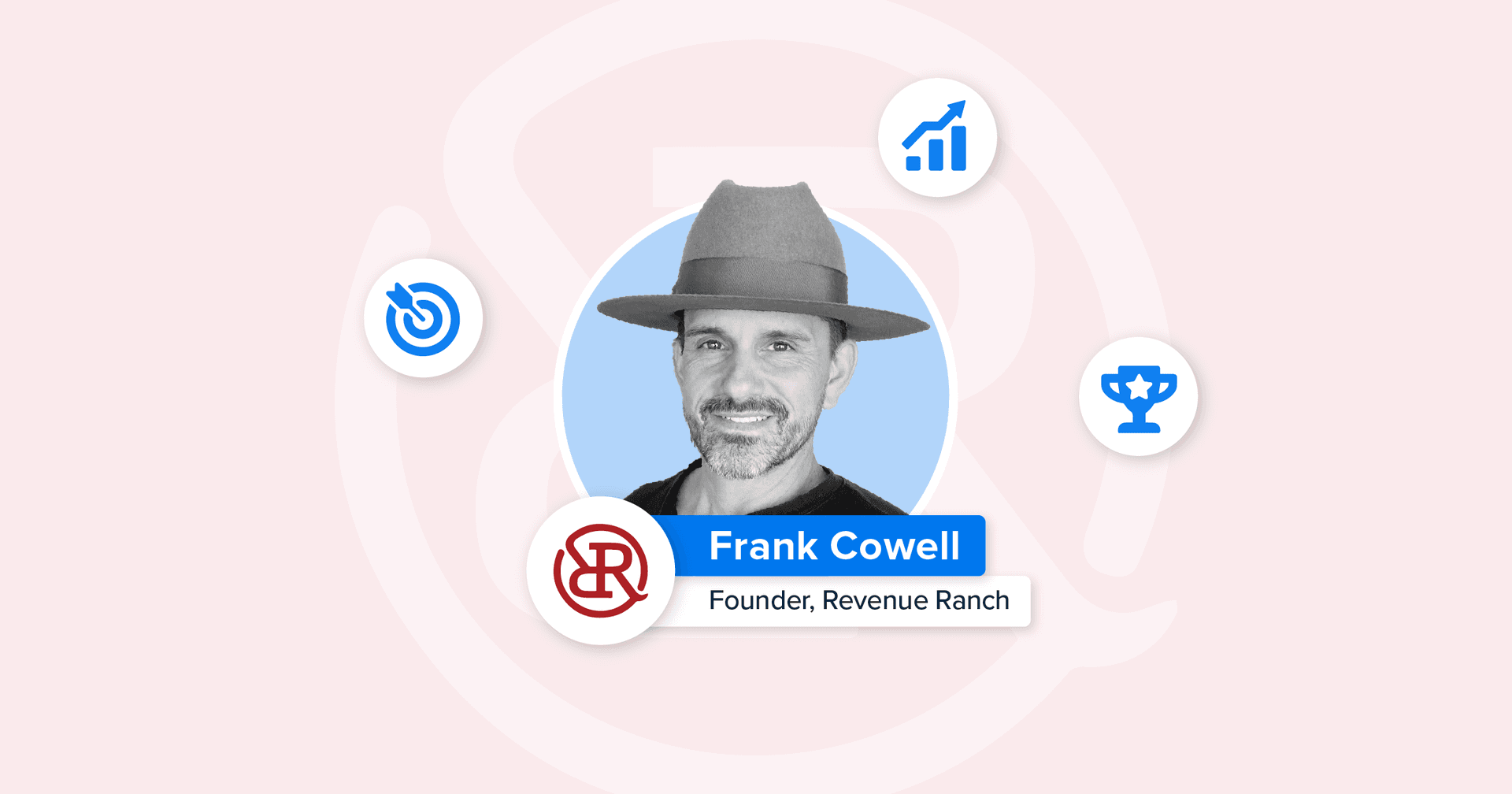Table of Contents
Table of Contents
- How Does the Entrepreneurial Operating System Benefit Agencies?
- The Legal Considerations of Implementing EOS at Your Agency
- Employee Perception and the Impact on Agency Culture
- The Risk of "One-Size-Fits-All" Solutions for Agencies
- How to Customize EOS for Your Marketing Agency
- Make EOS Work for Your Agency
7,000+ agencies have ditched manual reports. You can too.
Free 14-Day TrialQUICK SUMMARY: The Entrepreneurial Operating System (EOS) is a popular business framework that offers structure and clarity to the more than 170,000 companies that utilize EOS tools. However, some marketing agencies say its rigidity has the potential to hinder creativity and team morale. This article explores how adapting EOS helps balance structure with flexibility to support an innovative, thriving workplace.
Few books about entrepreneurship have garnered the attention and praise Gino Wickman’s Traction: Get a Grip on Your Business has had since its publication in 2011.
With more than a million copies sold, Traction remains the cornerstone of the Entrepreneurial Operating System (EOS), which helps business leaders accelerate company growth through a defined framework centered around vision, people, data, issues, processes, and (of course) traction.
According to EOS Worldwide, more than 170,000 companies use EOS tools, and more than 17,000 run entirely on the Entrepreneurial Operating System. Traction represents 60% of the book sales in the EOS library—which also includes Get a Grip: An Entrepreneurial Fable and How to Be a Great Boss! (both co-authored by Wickman).
Therefore, it’s no surprise that many agency leaders have implemented EOS to fuel their businesses, rise beyond growth plateaus, and expand their client base.
EOS is a huge player in our growth, our success, our being able to do what we do.
Kim Walker, Co-Owner, Shop Marketing Pros
However, while many agencies have succeeded with EOS, this doesn’t mean the system is without its flaws.
In this article, I’ll discuss the benefits and pitfalls of EOS—including employee perception, data protection and privacy, legal implications, and workplace culture concerns—specifically for marketing agencies looking to implement the system.
How Does the Entrepreneurial Operating System Benefit Agencies?
The Entrepreneurial Operating System (EOS) is built around six core components and tools to help organizations gain traction and optimize their operations.
After implementing EOS, we've been able to establish a really clear vision of where we are going as a company and how we're getting there.
Brian Ferrito, Digital Marketing Director, 42Connect
Here's how each of these components is relevant to marketing agencies:
1. Vision
This component ensures that all team members are aligned with the agency's direction and what it aims to achieve in the short and long term. A well-defined vision helps guide marketing strategies, client engagement, and brand development.
EOS Tools: Vision/Traction Organizer (V/TO) helps define and share the vision with the team.
2. People
EOS focuses on getting the “right people in the right seats,” which means having team members who fit the company culture and excel in their roles. This is essential in a service industry where the quality of work and client relationships are tied to each person’s capabilities.
EOS Tools: People Analyzer and GWC (Gets it, Wants it, Capacity to do it) ensure that team members are well-suited for their roles.
3. Data
EOS emphasizes using real, objective numbers to manage the agency. Accurate data helps marketing leaders make informed decisions, whether tracking campaign results, measuring client acquisition costs, or analyzing profit margins.
EOS Tools: Scorecards and Measurables provide a clear, data-driven insight into the agency’s performance.
4. Issues
Challenges and obstacles are inevitable. This component focuses on identifying, discussing, and solving issues effectively and efficiently. Addressing issues promptly helps prevent them from hindering a project’s success or client satisfaction.
EOS Tools: Issues List and IDS (Identify, Discuss, and Solve) process help agencies tackle problems head-on.
5. Process
This component involves documenting how work is done so everyone understands best practices and reliably replicates success. This is especially crucial for maintaining quality as the agency scales.
EOS Tools: The Process Documenter helps map out and refine processes.
6. Traction
Traction involves bringing discipline and accountability into the organization, ensuring the vision is brought to life with a real, executable plan. In a marketing agency, having strong traction ensures that everyone is focused and aligned with the agency’s strategic goals.
EOS Tools: Rocks (key priorities), Level 10 Meetings, and Accountability Charts help maintain focus and execution on a day-to-day basis.
The EOS method embodies the principle that "the whole is greater than the sum of its parts." Through this approach, team members set clear, strategic objectives ("Rocks") that guide their daily activities, collectively driving the agency’s overall financial success.
This system empowers agency leaders to delegate responsibility, foster autonomy among team members, and achieve shared goals, effectively positioning the agency for sustained achievement and growth.

Why EOS Isn’t Always the Best Solution for Agencies
Marketing agencies are unique because they must excel at being creative and responsive to their clients' changing demands. This sometimes clashes with EOS, which is more about sticking to a set structure and measurable goals.
For starters, creativity is the bread and butter of marketing agencies. They must develop fresh, original ideas to stand out. EOS focuses a lot on setting specific goals and following processes, which is generally a good thing. However, this approach may feel restrictive to creative types who thrive on flexibility and spontaneity.
Then there's the need for agility. Marketing campaigns often have to change direction quickly based on what the client needs or market shifts. The EOS method wants businesses to set firm quarterly goals, known as "Rocks," but this rigidity might not leave enough room for quick pivots.
Finally, the work culture in marketing agencies often revolves around teamwork and bouncing ideas off each other in a casual setting. The formal structure of EOS meetings, like the weekly Level 10 Meeting, may feel too stiff in a space where people are used to more informal collaboration.
Agency Advice: With its unique terminology, repetition/affirmation, emphasis on total buy-in from all team members, and strict adherence to structure, EOS often comes across as dogmatic. However, many businesses find the system’s clarity and structure helpful, particularly when implemented thoughtfully.
There are a lot of moving parts and pieces to it, so it's not simple. It is challenging to implement. In fact, having said that, we hired an implementer, someone outside of our company—let's call him an EOS coach. He helps us implement the program horizontally and vertically throughout our entire operation.
Kim Walker, Co-Owner, Shop Marketing Pros
So, while EOS does help bring some much-needed order and focus, marketing agencies might need to tweak it a bit (or hire an “implementer,” which carries additional costs). It’s essential to find the right balance between the discipline EOS provides and the creative freedom marketing agencies need to really shine.
The Legal Considerations of Implementing EOS at Your Agency
Implementing EOS or similar frameworks in marketing agencies may create several potential legal challenges, particularly in the areas of discrimination, privacy, and employment laws. Agency leaders need to be aware of these risks and manage them proactively.
Discrimination
One of EOS's key components is ensuring you have the "right people in the right seats." While this is crucial for efficiency and productivity, it must be handled carefully to avoid discriminatory practices.
For instance, if the criteria for determining whether someone is the "right person" are not objectively defined and consistently applied, there could be risks of discrimination based on age, race, gender, disability, or other protected characteristics. Decisions about hiring, firing, or promotions must be based on clear, job-related criteria to avoid any perception or reality of bias.
Employment Laws
Implementing EOS often involves changes to workflows, job roles, and employee expectations. These changes may have implications under various employment laws.
For example, if EOS implementation leads to job terminations, agencies must ensure these terminations are handled in accordance with local labor laws, which might require providing adequate notice, severance pay, or other considerations.
Additionally, if the implementation of EOS results in significant changes to job roles, this might necessitate revisions to employment contracts or re-negotiation of terms, which must be handled in line with legal requirements.
When Colorado agency OTM implemented EOS, they realized elements of the system didn’t work for them—especially when it came to managing employees, with some of the EOS practices they called “borderline illegal” in Colorado. (EOS has been criticized for enabling micromanagement, enforcing mandatory meetings even during vacation and sick time, and creating toxic workplace cultures with its GWC tool, leading to dismissals and firings.)

The OTM team hosting a book club reading Gino Wickman’s Traction, a guide to EOS. (Credit: OTM)
To remediate these concerns, OTM adapted parts of EOS and combined them with another business management framework, StratOp.
StratOp is short for “Strategic Operations”—a planning framework that bridges the gap between strategy and execution. It helps agencies stay focused on long-term goals while keeping day-to-day operations running smoothly.
Instead of separating big-picture strategy from hands-on execution, StratOp brings the two together. The goal? Speed up execution, learn faster from strategic decisions, and spot where things need improving in real-time.
Key Components of StratOp Include:
Strategic Thinking - Define your agency’s vision, direction, and long-term goals.
Operational Execution - Keep daily work aligned with the bigger picture so that everything you do drives results.
Financial Alignment - Make sure your budget and resources support both your vision and your operations.
We fully adopted EOS and then realized there were compliance or logistical areas that we really needed to expand on. The core is still EOS. It's just expanded to meet our needs.
Miles Kailburn, CEO & Co-Founder, OTM
EOS's emphasis on accountability and metrics may also tread into tricky legal waters if not managed carefully. For instance, if performance metrics are used to deny opportunities or promotions, the criteria must be clearly linked to business needs and applied uniformly to all employees to prevent claims of unfair treatment.
To address these challenges, marketing agencies should consult legal experts when implementing systems like EOS. Legal counsel will help ensure the agency's approach to hiring, data management, and employee relations is effective and compliant with relevant laws, safeguarding the agency against potential legal issues and fostering a fair and productive workplace.
Employee Perception and the Impact on Agency Culture
As we’ve discussed, EOS places a strong focus on metrics and putting the "right people in the right seats." While this emphasis certainly helps boost productivity, it may also impact agency culture and employee morale.
First, let's talk about metrics. The idea is that tracking clear, objective numbers keeps everyone accountable and ensures everyone contributes to the agency's goals. However, this data-driven approach is sometimes taken too far, reducing employees to numbers on a spreadsheet.
If everything is measured and evaluated based solely on key performance indicators (KPIs), it’s easy to see how a high-pressure environment could be created in which people feel like they're constantly being judged. This would lead to stress, burnout, or even toxicity and a sense of being undervalued, especially if the metrics don't capture the full scope of their contributions.
Then there's the idea of "right seats," which means ensuring that every employee is in the role that best matches their skills and aligns with the agency's goals. EOS puts a huge emphasis on business restructuring. While this sounds logical, the process of finding the right seat might leave some employees feeling insecure about their job stability.

An Amazon review of Gino Wickman’s Traction highlights the concerns leaders and team members have about EOS’s emphasis on “right people in the right seats.”
Additionally, an overly strict focus on finding the "right seat" may stifle career growth or discourage employees from exploring different roles. In creative marketing agencies, this rigidity might suppress creativity and make people less willing to take risks or experiment.
Ultimately, a strong focus on metrics and seating people correctly is valuable, but agencies need to strike a balance. Leaders should ensure that the culture doesn't become too numbers-driven or rigid and that employees feel recognized for their unique contributions. This means celebrating both quantitative achievements and qualitative strengths like creativity, teamwork, and problem-solving.
By creating an environment where metrics support and don't overshadow individual and team success, agencies foster a culture where people feel motivated, secure, and valued.
We run EOS, so we have a very clear vision for growth. We want to remain a small, focused, specialist agency. But we do want to grow in terms of team numbers and revenue numbers—and also in terms of how we can support our team and grow our team culture.
Alex Faiers, Founder, Addictivity
The Risk of "One-Size-Fits-All" Solutions for Agencies
The idea that one system, like EOS, is a universal fit for all businesses sounds appealing but is unrealistic, especially for creative fields like marketing agencies.
Instead of treating EOS as a strict formula that needs to be followed to the letter, it's more practical for marketing agencies to adapt it to their specific needs and culture, like OTM did. This means taking the valuable principles EOS provides—like setting clear goals, fostering accountability, and creating efficient processes—and tweaking them to fit the unique environment of an agency.
In January, we have a kickoff session. We give them a playbook—this is what the year’s gonna look like. We show all our Rocks for the quarter, and they can get involved in their Level 10 meetings.
We're transparent on the numbers: This is how much the company is going to make this year, this is the profit it needs to make, and this is how it affects your salary and bonuses. We try to be as transparent as possible.
Vallene Kailburn, CPO & Co-Founder, OTM
Ultimately, any system should be a guide rather than a hard rulebook. Agencies will get the best results by understanding and respecting their own culture and using tools like EOS as a flexible framework, adapting it to fit their unique way of working rather than being constrained by it.
How to Customize EOS for Your Marketing Agency
Let’s circle back to EOS’s six core pillars and look at how agencies might tailor its components to better suit the nature of their team’s work.
1. Vision
Strategy: Craft a vision that goes beyond the usual metrics. Emphasize the agency's creative goals and the value of innovative work. Make sure your vision statement inspires your team, providing them with a clear and compelling reason to believe in the agency's future and their role in shaping it.
Leadership Role: Leaders should regularly reinforce this vision to align with the agency’s unique culture, incorporating creative input from all levels.
Good culture exists when a team of like-minded people share similar values, beliefs, ethical standards, and practices. This, in turn, leads them to feel like they belong and are a part of something that matters to them.
David Metcalf, Founder, Distl
2. People
Strategy: Use the "right people in the right seats" principle, but remain open to internal mobility. Recognize that creative people often have diverse skill sets and may thrive in varied roles over time. Create development plans encouraging team members to experiment with different responsibilities or projects.
Leadership Role: Foster a culture of support and mentorship, where leaders actively help employees grow into new roles that best match their evolving talents and interests.
3. Data
Strategy: Build a scorecard that captures the qualitative aspects of marketing work alongside hard numbers. Consider including metrics that reflect client satisfaction, campaign creativity, or teamwork, which are crucial for marketing agencies but don't always appear in standard business metrics.
Leadership Role: Leaders should use these scorecards to recognize a range of successes and ensure the team feels appreciated for its diverse contributions.
4. Issues
Strategy: Create an environment where issues are discussed candidly without fear. Encourage team members to raise challenges or propose improvements, especially in creative processes. Use the "Identify, Discuss, Solve" (IDS) methodology while being receptive to out-of-the-box solutions.
Leadership Role: Leadership should model transparency and inclusivity, showing it's okay to challenge existing practices to achieve better creative results.
5. Process
Strategy: Standardize processes only where they add value and ensure quality, but avoid over-structuring creativity. Focus on processes that streamline administrative tasks so the creative team can spend more time on their work.
Leadership Role: Encourage employees to refine processes collaboratively, fostering a culture where feedback is valued and positive change is recognized.

Incorporate AgencyAnalytics in your EOS strategy to streamline manual reporting work and save billable time for your team’s creative tasks. Try it free today!
6. Traction
Strategy: While maintaining quarterly Rocks for essential business goals, leave room for experimentation. Set aside space for “creative Rocks” that allow for testing new ideas, tools, or approaches.
Leadership Role: Regularly acknowledge progress toward these goals in a way that motivates continued innovation, creating an environment where people are eager to take initiative.
Throughout the EOS process, ensure enough flexibility to adapt to changing market trends and client needs. To keep employees engaged:
Conduct informal check-ins beyond the Level 10 Meetings and provide space for creative brainstorming and informal updates.
Encourage employees to pitch their own ideas and experiment with new approaches.
Create a continuous feedback loop that allows employees to share what’s working and what isn’t with the EOS implementation and adjust accordingly.
Publicly recognize creative achievements, successful pivots, and innovative problem-solving to build morale and maintain enthusiasm.
By being flexible with EOS and adapting its components to the creative nature of marketing work, agency leaders will foster a positive, supportive workplace that maximizes structure and innovation.

Make EOS Work for Your Agency
Many marketing agencies have benefited from implementing the Entrepreneurial Operating System, using its framework to clarify goals, streamline operations, align teams, and grow.
Prior to EOS, we were dealing with some major organizational issues. For two years, we plateaued in terms of number of clients, our employees, and revenues. So, we were looking for a business framework that would help us define and clarify who we are as an organization, where we are going, and how we're going to get there.
Dan Delmain, Founder, :Delmain
However, it’s easy to see why agency employees may bristle when faced with inflexible quarterly goals and obligatory structured meetings that hinder their creative process. The "right people in the right seats" approach may also create job insecurity and discourage them from experimenting or taking risks, which contradicts agency goals for culture and collaboration.
While EOS certainly provides valuable tools for growth and accountability, marketing agencies should consider adapting the framework to fit their specific culture and needs. Striking a balance between structure and flexibility will allow agencies to maintain an innovative environment that thrives while still taking advantage of the visionary focus EOS brings to the table.

Written by
Francois Marchand brings more than 20 years of experience in marketing, journalism, and content production. His goal is to equip agency leaders with innovative strategies and actionable advice to succeed in digital marketing, SaaS, and ecommerce.
Read more posts by Francois MarchandSee how 7,000+ marketing agencies help clients win
Free 14-day trial. No credit card required.





